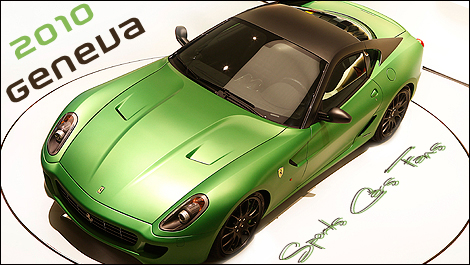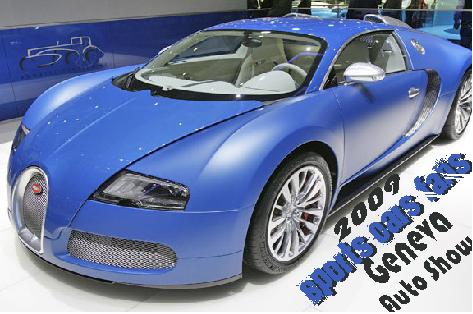First Drive: Bugatti Veyron 16.4 Grand Sport

The Bugatti Veyron Grand Sport is a violent, taunting, confounding and punctiliously engineered maelstrom. It is a handmade wonder built in a castle, and yet resembles a slightly squashed jelly bean. It has a $30,000 stereo, but it's too much work to actually listen to it. The 16-cylinder, quad-turbocharged engine with 1,001 horsepower and 922 lb-ft of torque is programmed not to let you damage it, but in just one afternoon, the leather-trimmed coachwork on the doors will be a mess of shoe marks. The car's brake rotors are chaperoned by 28 brake pistons, but using them forcefully is like begging someone to plow into the aforementioned engine. The car will cost you €1.6 million (roughly $2.24M USD), for which you get, as a soft top, an umbrella. That's right, an umbrella. Own it and you'll be master of the quickest accelerating production car in the world, and yet you'll probably never remember what that acceleration is like.
When we drove the Veyron coupe, we admitted to not being carried away by its looks, but we found a greater appreciation for the lines of this car. Excising a portion of the roof doesn't change our minds, but that isn't to say that the design doesn't look good. More importantly, that isn't to say that the Bugatti doesn't have a certain... something... that will impress itself upon you even after just one meeting. From the side, although the car's surfaces are austere, how they intersect in three dimensions is rather lively. Our favorite line is from the rear three-quarter, the fender edge that forms the shoulder of the door then appears to turnabout in a varying-radius 180, back to the front wheel, and delineates the top edge of sill.
That, however, is actually a trick of the eye. From the side and especially the front, follow the line of the door and it's as if the car came in two pieces, with the narrower front slotting into a much more commodious rear component. It isn't usually a compliment to say "You have an ample hiney," but we can say that about the Veyron Grand Sport with no ill intent. It is serious business. Especially after being beguiled by that low, rolled-back front end, to happen upon the swelling, blunt force trauma of the stern is like discovering that the dainty girl you're on a first date with is actually built like Vladimir Klitschko underneath her dress.
In this car's case, those two personalities make sense, and the lines chosen to adorn them fit and flow with quiet sense. Yet return to that innocent front end, and it doesn't quite look the same anymore because you know what's hiding in that indecent rear: a plasma reactor.
The car might not be Botticelli, but it is without a doubt bodacious.
We can admit that even though we've driven the coupe, we had no idea what the Bugatti Veyron really was. We didn't understand it – sure, we had a great time and the car is distortingly fast and stupendously powerful and really expensive and simple to drive and Volkswagen supposedly loses money on every one them and blah blah blah. Frankly, that could be a lot of cars. After spending an evening and the following day with an engineer and finding out what's really going on inside the car, we get it. We get why the car is so expensive and still loses money. You simply couldn't start an entire car company, create this as your first and only offering, and make money. The car is stupendously engineered.
The engineering of the Bug can be barely compared to other cars – it's more like an F-16. It cannot be driven without its computers, and there are 27 ECUs and computer-based controllers throughout – and that doesn't account for all of the car's computers. The four drivetrain ECUs for the engine, transmission, ABS and stabilizing system, and Haldex clutch are always in contact and must be in working condition, or else the car won't operate. But just in case there's a problem, each ECU has an emergency program so the car won't stop in the middle of whatever you're doing – all you'll see is a dashboard light and experience reduced power when the car enters safe mode. The rear wing serves braking, aero, and cooling purposes. When raised at 110 mph during braking, it jumps up to a 60-degree angle and withstands 800 kg (1,760 pounds) of pressure. Fully extended for emergency braking, it raises the car's coefficient of drag from .39 to .68. Hydraulics able to handle the pressure at top speed couldn't be fitted with obstruction detectors, so the tail lowers slowly, in stages, to give everyone and everything time to get out of the way of it and its housing in the rear panel. Conveniently, the car detects automatically if you're running on snow or ice.
The Bugatti's engine wants to live, and will protect itself any time it detects impending damage. It won't shut off, it will simply detune itself to the point where no damage will be caused and respectfully ask to be taken to the shop. If the oil pressure goes down too low, the engine will lower the allowable RPMs. If you can't get 98 octane fuel, the engine will automatically retune itself to the octane you can get, even 91.
To turn the coupe into an adequate targa, the tub was reinforced and the door material was switched from aluminum to carbon fiber. The B-pillars get carbon fiber hoops and the intake faces get their own carbon fiber hoops as well. The transmission tunnel underneath the car, formerly open, is closed off with a stiffening carbon plate.
And the car still goes 253 mph. If Bugatti had spent all that development money just on the going fast, it would be worth it.
But they spent in a lot of other places as well. Open the front door, lower yourself into backstitched carbon buckets, and pull out the... oh my goodness, is that a switchblade key? Like you get with a VW Lupo? Yes, it is. Anyway, flick the switchblade, place the key in the ignition, and turn. Nothing happens. Push the brake pedal and press the start button on the gilded center console.
Then it happens.



You have just ignited a quasar (which is a much more accurate term for the 16.4 engine). The insatiable beast is fed by the two intakes above your head, and they are trying to suck up everything. At least, that's what it sounds like.
Bump the gearshift to the right, let off the brake, and pull into traffic, taking your celestial body with you.
Once in any public area, you find three types of Bugatti people: those who have no idea what it is but think it's beautiful, those who have no idea but think it's a Bentley (this happened at least once an hour), and those who know it and would feed anyone to the wolves to keep up with it and shoot it.
Among many other incidents, on the always-packed Interstate 5 freeway between LA and San Diego, a man in a minivan with his family turned into Kyle Busch trying to keep up; an early-Eighties Honda Accord hopped a lane and nearly drove into a Ford F-350 in order to let us by so the driver could take a picture; and a gentleman in a Nissan Altima tailed us for 50 miles with one hand on his iPhone snapping photos the entire time. Wives, girlfriends, children, other drivers, the endangered Alabama Cavefish... they're all expendable! It doesn't matter who has to die. They're going to get a photo.
At a fixed speed behind the wheel, the driving experience is, dare we say it, prosaic. At low speeds, you simply amble along. The car is using perhaps a tenth of an iota of its capabilities. But as long as the quasar behind you is being fed, it does not complain.
Even at highway speeds, the car doesn't beg for attention – not from the driver. Between the intakes and the wind noise, you won't want to bother with conversation, that sybaritic stereo, nor the new iPod connection, but you're not missing out on anything. Driving, and watching out for loons, is all you want for.
Play around with the acceleration and it's as if the turbos have three settings: Mild, Let's Get Ready to Rumble, and "Gadzooks!" Be kind with the throttle and the turbos lurk in the background. Stabbing on the gas calls all of them out of their hiding places, and as the quasar prepares to explode, the noise through the intakes – the noise a few inches above your scalp, mind you – becomes a calamitous howl. If you heard the sound in a horror movie, you would cover your eyes, all the while knowing that something is going to die now.
At that point, you have 1.5 seconds to either get off the throttle or be launched into whatever is in front of you.
If you don't stab the throttle but simply call for a little more power, the turbos go on standby like Minutemen. You get your extra boost, and they wait with guns ready to fire.
And then you come to the "Gadzooks!" setting.
It is quite impossible to describe malevolent acceleration in the Veyron Grand Sport by using the same terms you'd use for normal cars. So we'll try some analogies to give you an idea of what it's like.
First of all, you don't accelerate in the Veyron Grand Sport. That is what humans do in their puny human conveyances. You evaporate, and then you reappear somewhere down the road. And if someone, like a police officer or maybe St. Peter, were to ask you what happened, all you could say is "I think I remember pushing my foot down, like this... and then... I was here..."
Because you don't remember accelerating. You can't. It happens too quickly for you to capture any memories.
Imagine this: You're taking your daily walk in the woods. You know the path, there's nothing new here. But then one time when you put your foot down, you hear a momentous bit of crashing and a roar almost on top of you. And then, get this, a Saber Toothed Tiger jumps out of the bushes right behind you. (We know what you're thinking, but stay with us for a minute here).
You don't know where the Saber Toothed Tiger came from, but you don't you don't care. There is no more thinking, there is only an urge: run run run run run ohmygod run run run ohmygod... I wanna live!
Your body takes care of the rest because it's fight-or-flight, and the situation is so foreign, so intense that you can't be bothered with conscious thought.
Accelerating in the Bugatti is like the flight part. Your body takes over. You have no time to think about it.
So your mind, sent on a vacation, daydreams. You think of your second grade teacher, or the rose you got on Sadie Hawkins Day in junior high, or that victory on the college track team, or getting your first promotion. You think happy thoughts. Gentle thoughts.
Then you notice the windows automatically roll up, and somewhere in the recesses of your dura mater you remember "They told me that happens at 100. Ah well... Where was I?"
And then you go back to daydreaming... your first kiss... your puppy, maybe you'll name him "Schooner"...
Then your brain, on automatic, detects something ahead and moves your foot from the throttle to the brake. As the car slows down you begin to come to, consciously, at about 70 mph. You look at the trees and think "Hmm, this looks different!" Of course it does. You just covered three miles. And you got there the day before you left.



Trying to find a place to use this power isn't easy. In fact, if you can see anything on the horizon – today or tomorrow – you'll probably run over it.
That's how fast this car is.
This is where you discover that the Veyron isn't even really a car – it is a Zen philosopher that travels the brightline between the mind-body split.
There is mind, that lump you use to consciously think.
When you want to get rid of it, press the Grand Sport's gas pedal to the floor.
And then there is no-mind. There is only peace.
And that is in the Grand Sport's Normal mode.



The most quixotic item on the Veyron Grand Sport is a letter "S" on the gear shift. It's for "Sport" mode. Which, one realizes, is like putting a supercharger on a missile.
Place the car in Sport mode and it descends a gear. This puts the car at DefCon 1. Bury the throttle now and there's no pause between trigger pull and explosion. It is instant go. This is acceptable if there is no one on the road near you – and remember our definition of "near." But you must pay close attention, because without that 1.5-second gap, every shot could be your last.
There is, however, one other thing as ludicrous as going muzzle velocity in a Bugatti is this: coming to a stop.
The Bugatti's carbon ceramic brakes are 15.75 inches in front, with eight-piston calipers squeezing four pads apiece. In back, the brakes are 15 inches and wear six-piston calipers with two pads apiece.
But those are mere numbers.

Again, we need to make some outrageous comparisons in order to convey meaning.
Slamming on the brakes at high speed is like rear-ending a battleship – except no body panels and no battleships get hurt in the process. It isn't braking. It's crashing without the noise and the insurance claim.
In your peripheral vision, if there's a passenger, you'll catch a scene that's just like an NHTSA frontal impact video. As you're watching his chin burrow itself into his sternum, you keep asking yourself "What did we hit?! How did I not see it?!"
After doing it once you think, "I don't need to do that again." But you do. Because given a little time you're unsure of whether it was really that violent. You can't remember whether you really did sense several of your internal organs simply quit working on the assumption that you were obviously about to die.
And you really can't believe that you're actually in control of it. You look at the brake pedal like you'd look at the button that initiates nuclear war: "Man. Can that little thing really exterminate entire civilizations?"
So you do it again. And you realize: Yes. It can.
When it's over, you place your hands on the sides of your head and lift, removing your chin from your solar plexus. Then you continue driving as if you hadn't been sucker punched by Zeus.
Frankly, though, none of that is the story. The real story of the Bugatti Veyron Grand Sport is this: it's a Golf. Powered by the energy of ten million suns.
No, it really is a Volkswagen. And not one of those nice VWs like the Phaeton. I'd remember I was driving a Phaeton. The Veyron encourages not even thinking about driving, like one hand on the wheel and the other clutching a Dairy Queen Blizzard. This is a supercar, mind you, and we are prone to forgiving supercar foibles. Yet the Veyron Grand Sport has dispensed with almost all of them.
The components have been tested to six-digit endurance. As one of the techs said, "You buy some cars and you've got to replace the clutch at 4,500 miles. We tested everything to 100,000 miles." The carbon brakes, even at cold startup, never get grabby, so there's no lurching. Never. The car was tested day after day in Tokyo rush hour for hours on end and doesn't overheat. In stop-and-go on the 405, the temperature gauge didn't move. The suspension is compliant – a Porsche is less composed over freeway lane dots than the Bugatti. For that matter, a Hyundai Genesis Coupe is less composed. Steering the Grand Canyon-filling wheels can be done with one hand. You can see out of it, except for directly back, for which there's a rear view camera. The car neither squeaks nor rattles. The seats are comfortable for hours. It isn't jumpy, the throttle being crisply, smoothly linear.
Which means you can have the best of... let's see... everything. And whenever you want to forget who you are and just think happy thoughts, push down on the throttle and the serene, peaceful no-mind of Zen is yours.
Just tell your reptilian brain to watch out for the horizon. It comes up really, really fast.
[Source: Autoblog]















